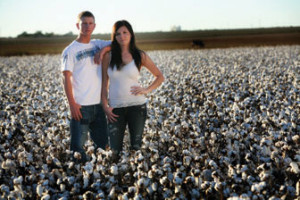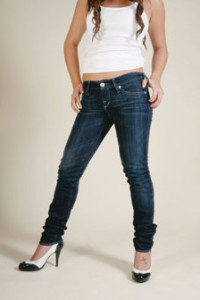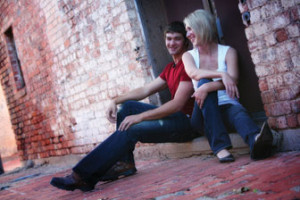By Amy Dromgoole and Photos By Savant Photography
 In the past 25 years, stretch denim has been brought to the forefront of the denim market. During this transition, the entire industry, especially American Cotton Growers (ACG) in Littlefield, Texas, has made strides to keep up with the demand for the product and provide consumers with a valued product.
In the past 25 years, stretch denim has been brought to the forefront of the denim market. During this transition, the entire industry, especially American Cotton Growers (ACG) in Littlefield, Texas, has made strides to keep up with the demand for the product and provide consumers with a valued product.
Stretch denim is made when core-spun yarn is spun around a spandex filament in order to give it stretching capability. Ninety-nine percent of all stretch denim made around the world contains spandex in the yarn. The filling is placed in the horizontal weave of the fabric. It is beneficial to use spandex in the filling in order to allow for jeans to stretch across the body rather than vertically.
Denim of this kind is made with the principle of weaving the cloth with enough opening in the weave to allow for shrinkage in the width when the garment is washed. This openness in the weave also allows the filling yarn to be extended, or stretched, when force is applied. The small amount of spandex filling pulls the fabric back into place after force is released allowing for recovery in the shape.
Stretch denim is treated with a process that gives the denim a “flat” appearance and keeps the fabric from stretching when made into jeans.
 First, a prep range will pre-shrink the fabric in the width by brushing and singeing loose fibers, applying a caustic soda chemical to the fabric in order to give it the flat appearance, and skewing the fabric in order to keep the fabric from twisting when constructed into jeans. Next, a machine called a sanforizor pre-shrinks the denim vertically to complete the process.
First, a prep range will pre-shrink the fabric in the width by brushing and singeing loose fibers, applying a caustic soda chemical to the fabric in order to give it the flat appearance, and skewing the fabric in order to keep the fabric from twisting when constructed into jeans. Next, a machine called a sanforizor pre-shrinks the denim vertically to complete the process.
According to Jack Mathews, Vice President of Fabric Sales and Product Development at Plains Cotton Cooperative Association, there are three categories of stretch denim: comfort, traditional and power stretch. Comfort denim is found in men’s jeans where very little stretch is needed while traditional and power stretch denim is used in the women’s market. Stretch denim demands mostly come from the women’s and girl’s retail segments because of the need for a form-fitting, comfortable product.
Most women’s jeans are made from stretch denim,” Mathews said. “The female consumer loves stretch denim because it allows her to wear a tighter fitting jean that’s comfortable and retains its shape after repeated wear. Because the spandex fiber is wrapped in cotton, stretch denim jeans still have the great soft hand that only cotton provides.”
Stretch denim in the men’s market is still a niche business. Most men’s stretch denim jeans are made from fabrics that are designed to stretch less, usually in the range of 15 percent compared to women’s that can stretch up to 40 percent.
However, as the industry expands into a higher end premium men’s market, a shift to more traditional stretch denim fabrics is occurring. This shift will allow for men’s jeans to stretch closer to 20 or 25 percent.
In addition to the common demand for the fabric in women’s clothing, a recent garment named “jeggings” also has become a popular trend in  high fashion circuits. These garments resemble knit leggings but are made from woven stretch denim that’s designed for maximum stretch and recovery. Jeggings will stretch between 35 and 45 percent.
high fashion circuits. These garments resemble knit leggings but are made from woven stretch denim that’s designed for maximum stretch and recovery. Jeggings will stretch between 35 and 45 percent.
“The need for this fabric won’t go away,” Jack Matthews said.
“Over the past decade, we have seen stretch denim come to dominate female jeans wear to the tune of 80 percent of the market,” Mike Windham, project coordinator at ACG, said.
ACG has always had a significant presence in the men’s business. Mathews estimates that today approximately 75 to 80 percent of ACG denim fabric sales are for the men’s market.
However, the Denimatrix business model is more balanced with men’s and women’s markets each representing about 50 percent of the business. This balance should provide significant opportunities for ACG to increase its fabric sales into the women’s market. Prior to the creation of Denmatrix by PCCA in 2009, most stretch denim had been made in Asia.
“Before Denimatrix, 75 percent of the jeans ACG produced were for men and 25 percent for women,” Mathews said. “However, our production now rests at 50 percent for both men and women.”
ACG now produces 60,000 pounds of core-spun yarn weekly and is the only facility in the Western Hemisphere with the capacity to produce this quantity of fabric. ACG currently has six machines, three of which produce core-spun yarn and three that produce 100 percent ring spun cotton yarn. However, due to the increased demand for stretch denim, in July of 2010 ACG will add attachments to two of the ring spinning frames. With this addition, five of the six machines will have core-spinning capabilities.
The beauty of these frames is that as minor shifts happen in the marketplace we can convert the machines back and forth between ring spinning and core-spinning,” Mathews said. Nonetheless, the demand for stretch denim is not expected to change anytime soon.
“The need for this fabric won’t go away,” Mathews said. “The weave, color and yarn character might change in order to keep up with various trends, but its value in terms of comfort make it a staple.”


